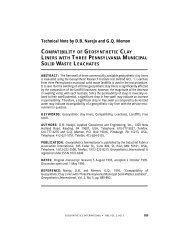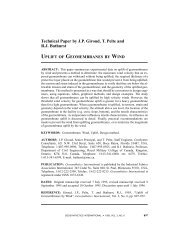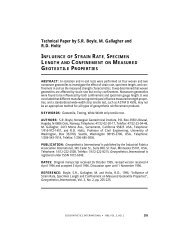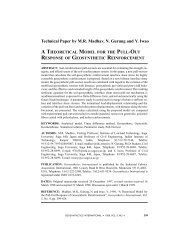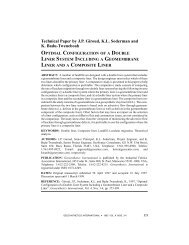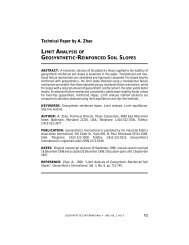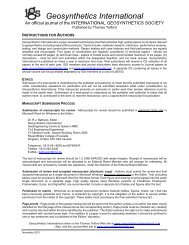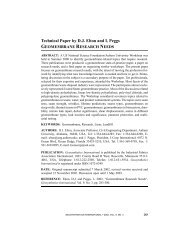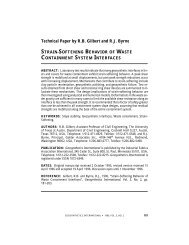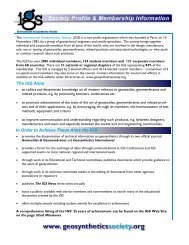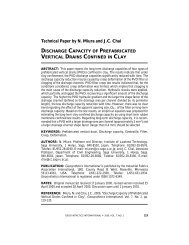Technical Paper by J.H. Greenwood - IGS - International ...
Technical Paper by J.H. Greenwood - IGS - International ...
Technical Paper by J.H. Greenwood - IGS - International ...
You also want an ePaper? Increase the reach of your titles
YUMPU automatically turns print PDFs into web optimized ePapers that Google loves.
Discussion and Closure<br />
DESIGNING TO RESIDUAL STRENGTH OF<br />
GEOSYNTHETICS INSTEAD OF STRESS-RUPTURE<br />
TECHNICAL NOTE UNDER DISCUSSION: <strong>Greenwood</strong>, J.H., 1997, “Designing<br />
to Residual Strength of Geosynthetics Instead of Stress-Rupture”, Geosynthetics<br />
<strong>International</strong>, Vol. 4, No. 1, pp. 1-10.<br />
DISCUSSER: S-C.R. Lo, Senior Lecturer, School of Civil Engineering, University<br />
College, University of New South Wales, Canberra, Australia, Telephone:<br />
1/61-6-2688349, Telefax: 1/61-6-2688337, E-mail: srl@octarine.cc.adfa.oz.au.<br />
PUBLICATION: Geosynthetics <strong>International</strong> is published <strong>by</strong> the Industrial Fabrics<br />
Association <strong>International</strong>, 1801 County Road B West, Roseville, Minnesota<br />
55113-4061, USA, Telephone: 1/612-222-2508, Telefax: 1/612-631-9334.<br />
Geosynthetics <strong>International</strong> is registered under ISSN 1072-6349.<br />
REFERENCES OF DISCUSSION AND CLOSURE: Lo, S-C.R., 1997,<br />
“Discussion of ‘Designing to Residual Strength of Geosynthetics Instead of<br />
Stress-Rupture’ <strong>by</strong> <strong>Greenwood</strong>, J.H.”, Geosynthetics <strong>International</strong>, Vol. 4, No. 6, pp.<br />
673-675.<br />
<strong>Greenwood</strong>, J.H., 1997, “Closure of Discussion of ‘Designing to Residual Strength of<br />
Geosynthetics Instead of Stress-Rupture’”, Geosynthetics <strong>International</strong>, Vol. 4, No. 6,<br />
pp. 675-677.<br />
Discussion <strong>by</strong> S-C.R. Lo<br />
The author of the paper has presented a more rational and less conservative method<br />
for assessing the load carrying capacity of geosynthetics under long term loading. However,<br />
clarifications are needed to ensure the proposed method is applied in a way compatible<br />
with the design conditions and philosophy of the design code used. The latter<br />
cannot be over-emphasised because of the introduction of limit state design codes that<br />
use a series of somewhat confusing partial factors.<br />
In a limit state design code, partial factors are used in lieu of a single factor of safety.<br />
The design strength, T D , is obtained <strong>by</strong> applying a partial factor f m to T CR , the rupture<br />
strength at the specified design life obtained <strong>by</strong> extrapolation of test data. In the context<br />
of limit state design, f m is used to cover uncertainties in the determination of T CR and the<br />
loss in effective load carrying area (say, due to construction damage). In BS 8006<br />
(1995), f m is considered as the product of a number of partial factors f m11 , f m12 ,etc.in<br />
GEOSYNTHETICS INTERNATIONAL S 1997, VOL. 4, NO. 6<br />
673



